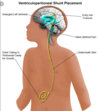1 - Topography of the Nervous System Flashcards
(30 cards)
What are the different components of the CNS and the PNS?
- CNS cannot regenerate but PNS can
- Cauda equina made up of dorsal and ventral roots

What is white and grey matter?
Grey: cell bodies and dendrities. Highly vascularised as metabolically active. In brain there is extra layer of grey matter on outside
White: made of axons and connects grey areas together. Fatty myelin makes it white
In the PNS grey matter is ganglion and white matter is peripheral nerve.

Define the following 3 terms relating to divisions of white matter in the spinal cord:
- Funiculus
- Tracts
- Fasiculus
Funiculus: a segment of white matter which contains axons going up and down the spinal cord
Tracts: connection between two areas of grey matter where the axons are only running in one direction
Fasiculus: subdivision of a tract which supplies a distinct region of the body

How is grey matter in the spinal cord split up?
- Into cell columns called Rexed’s laminae
- Motor neurones supplying a given muscle arise from multiple segments and form a nucleus

What is the definition of a fibre in the CNS and what are the three different types of fibre?
- Fibre: axon in association with its supporting cell e.g oligodendrocyte
- Association fibres connect the same hemisphere, commisural connect right and left hemisphere and projection connect cerebral hemispheres with cord/brainstem

What is a nucleus?
A collection of nerve cell bodies
What is the difference between dorsal and ventral roots?
- Dorsal: sensory
- Ventral: motor
What are the colliculi?
Reflex centre in the midbrain for rapid responses to sound and vision, e.g orientate head towards explosion

What are the functions of the brain stem?

What are the main sulci in the brain and their significance? e.g central

What is the function of the following and where on the inferior aspect of the brain are they located?
- Optic Chiasm
- Uncus
- Medullary Pyramids
- Parahippocampal Gyrus

What is the function of the following:
- Corpus Callosum
- Thalamus
- Cingulate Gyrus
- Hypothalamus

What is the function of the following:
- Fornix
- Tectum
- Cerebellar Tonsil

Where is CSF made, stored and reabsorbed?
- Made in the choroid plexus found in ventricles
- Has metabolic, immune and mechanical protection functions
- Circulates in ventricles and subarachnoid space then reabsorbed at arachnoid granulations

Draw and explain the ventricular system of the brain.

What issues can arise due to the cerebral aqueduct?

Really narrow so can get occluded and cause dilation of superior structures leading to hydrocephalus

What is a Jacksonian seizure?
Focal partial seizure starting in one area that can move proximally through the body as the seizure spreads down cortical homunculus

How is hydrocephalus treated?
Ventriculo-peritoneal shunt

Draw a diagram of a reflex arc.
Synapses in the ventral horn

What is the Jendrassik reflex?

Why does this meningioma show up when using Gd contrast and why does it need to be removed even though it is benign?

- Contrast is absorbed by the lesion as has caused a break in the BBB so can get through
- Could cause herniation and Cushing’s reflex so needs to be removed
Define the following terms:
- Aphasia
- Apraxia
- Dysarthria
- Dysdiadochokinesis
- Areflexia
- Chorea
- Agnosia
- Impairment of language, affecting the production or comprehension of speech and the ability to read or write
- Loss of the ability to execute or carry out skilled movements and gestures, despite having the desire and the physical ability to perform them
- Slurred or slow speech that can be difficult to understand
- Impaired ability to perform rapid, alternating movements
- Don’t have typical reflexes
- Abnormal involuntary movement disorder
- Inability to interpret sensations and hence to recognise things e.g recognise an object
What are the different types of spina bifida and how can you prevent this condition occuring?
- Take folate supplements 3 months before concieving to prevent this and cleft palate defects
- Myelomeningocele is the msot dangerous

What is the abnormality in this CT and how should this patient be treated?

- Dilation of the lateral ventricles as the cerebral aqueduct is blocked so hydrocephalus is occurring as impairment of CSF drainage
- Ventriculoperitoneal shunt









